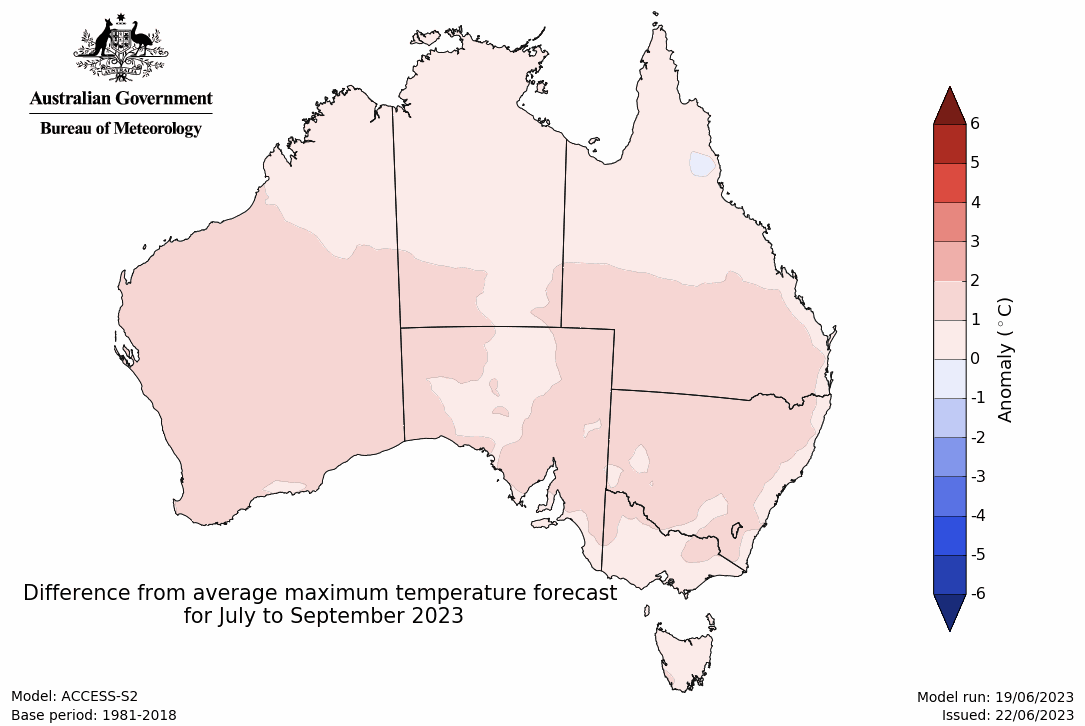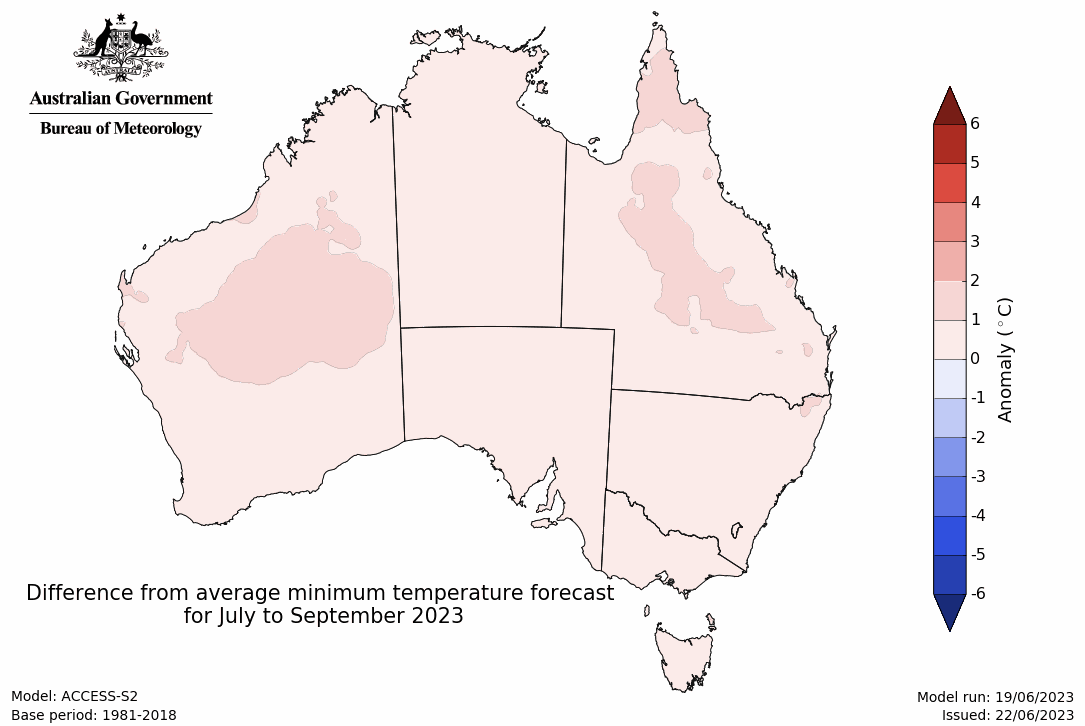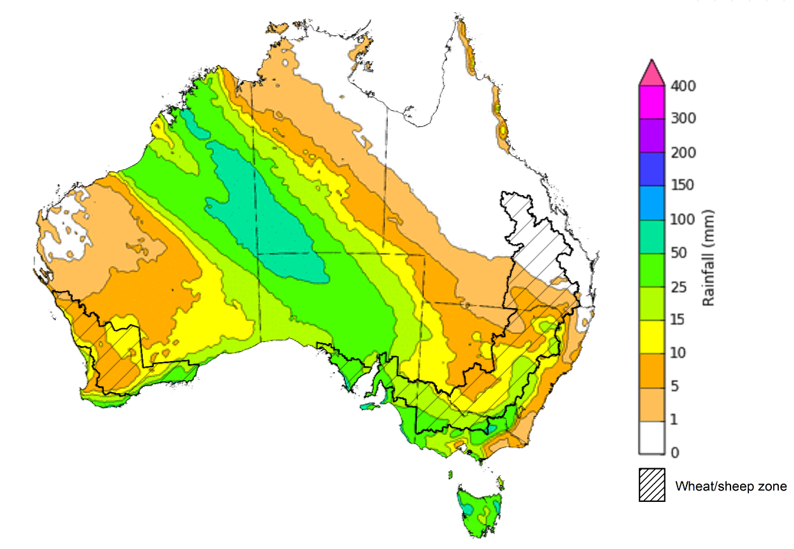Key issues
- For the week ending 21 June 2023, fronts and troughs crossed southern Australia and brought cold, wet, and windy conditions to southern South Australia, much of Victoria and Tasmania, and parts of southern New South Wales. A trough brought rainfall to the Pilbara region and cool onshore winds brought showers to the southern Western Australian coast. A high-pressure system kept the remainder of the country dry.
- Across cropping regions, rainfall totals of between 10 and 50 millimetres were recorded across southern Victoria, southeast New South Wales, western areas of South Australia and parts of eastern Western Australia. This rainfall would have aided the germination and establishment of later sown crops, benefitted soil moisture levels and the growth of earlier sown crops. Dryness elsewhere would have allowed growers to access fields for post-emergence spraying for pests and disease (see Section 1.1).
- The Bureau of Meteorology’s ENSO outlook is at El Niño ALERT. Sea-surface temperatures in the Pacific and some atmospheric indicators have reached the El Niño thresholds. There is also a strong possibility of positive IOD event developing this winter. A positive IOD can suppress winter and spring rainfall over much of Australia, potentially exacerbating the drying effect of El Niño (see Section 1.2).
- Across cropping regions, during July there is a 75% chance of rainfall totals to be between 25 and 50 millimetres across southern and eastern New South Wales and much of Victoria and South Australia, while falls of between 25 and 100 millimetres are expected in Western Australia. Below 10 millimetres is forecast for the remaining cropping regions. During July to September 2023, below median rainfall is more likely across cropping regions. There is 75% chance of receiving between 25 and 100 millimetres in the cropping regions, except for in northern Queensland where falls are expected to be below 25 millimetres. In areas with low soil moisture these probable low rainfall totals are unlikely to be sufficient to sustain average levels of crop production (see Section 1.3).
- Over the 8-days to 29 June 2023, a front and low-pressure system crossing southern Australia are expected to bring showery conditions to southern Australia. A trough should bring showers, up to 100 millimetres, across Western Australia’s north and interior and through to South Australia. A high-pressure system will keep north-eastern Australia dry (see Section 1.4).
- Across cropping regions, rainfall totals up to 50 millimetres are expected across much of Victoria and South Australia and in the eastern parts Western Australia. Falls up to 25 millimetres are expected across much of New South Wales. Little to no rainfall is expected across remaining cropping regions. If realised, this rainfall should be sufficient to allow for the germination and establishment of later sown crops and provide a significant boost to the soil moisture levels (see Section 1.4).
- Water storage levels in the Murray-Darling Basin (MDB) increased between 15 June 2023 and 22 June 2023 by 3 gigalitres (GL). Current volume of water held in storage is 20 603 GL. This is 1 percent or 268 GL more than at the same time last year.
- Allocation prices in the Victorian Murray below the Barmah Choke decreased from $11 on 15 June 2023 to $10 on 22 June 2023. Prices are lower in the Murrumbidgee due to the binding of the Murrumbidgee export limit.
Climate
For the week ending 21 June 2023, fronts and troughs crossed southern Australia and brought cold, wet, and windy conditions to southern South Australia, much of Victoria and Tasmania, and parts of southern New South Wales. A trough brought rainfall to the Pilbara region and cool onshore winds brought showers to the southern Western Australian coast. A high-pressure system kept the remainder of the country dry.
Across cropping regions, rainfall totals of between 10 and 50 millimetres were recorded across southern Victoria, southeast New South Wales, western areas of South Australia and parts of eastern Western Australia. Lighter falls of between 1 and 10 millimetres were recorded across Western Australia, southern New South Wales, northern Victoria and eastern South Australia. This rainfall would have aided the germination and establishment of later sown crops and benefitted soil moisture levels and the growth of earlier sown crops. Dryness elsewhere would have allowed growers to access fields for post-emergence spraying for pests and disease.
Rainfall for the week ending 21 June 2023
The climate drivers with the largest potential impact on Australia’s climate patterns are the El Niño–Southern Oscillation (ENSO), Madden-Julian Oscillation (MJO), Indian Ocean Dipole (IOD) and Southern Annular Mode (SAM). These climate drivers are likely to influence pasture growth across southern Australia and the growth and yield prospects for winter crops.
The Madden–Julian Oscillation (MJO) pulse is currently over the Western Pacific and is forecast to become indiscernible in the coming days. At this time of the year MJO has little influence on northern Australia rainfall.
The Bureau of Meteorology’s ENSO outlook is at El Niño ALERT, indicating that there is a 70% chance of an El Niño developing in 2023. Oceanic indicators are measured in terms of the sea surface temperature (SST) anomalies, which have warmed to El Niño thresholds. For the week ending 18 June, the SST were warmer than average over the central and eastern equatorial Pacific Ocean, with anomalies over 4°C in the far east. All models surveyed by the Bureau of Meteorology indicate the likelihood of further warming and the warm SSTs will remain above El Niño thresholds at least into the beginning of southern hemisphere summer.
Atmospheric indicators are measured in terms of the surface air pressure difference between Tahiti and Darwin, called Southern Oscillation Index (SOI), the direction and strength of the trade winds and cloudiness at the date line. Some atmospheric indicators such as the SOI have shifted towards El Niño thresholds. For the period ending 18 June 2023, the 30-day SOI was -14.1, the 60-day SOI was -10.7, and the 90-day SOI was -7.4. The gradual decrease in both the 30-day and 90-day SOI have entered the El-Niño threshold. However, winds, clouds and broadscale pressure patterns indicate that the ocean and atmosphere are yet to reinforce each other, as occurs during El Niño events.
30-day Southern Oscillation Index (SOI) values ending 19 June 2023
All international climate model surveyed by the Australian Bureau of Meteorology indicate the SSTs anomaly values will pass El Niño thresholds during winter and remain above El Niño threshold levels through spring and at least to the beginning of southern hemisphere summer.
International climate model outlooks for the ENSO in NINO 3.4 region
Issued: 20/6/2023
The Indian Ocean Dipole (IOD) is currently neutral with index value of 0°C for the week ending 18 June. All international climate models surveyed by the Bureau of Meteorology suggest that thresholds values for a positive IOD event are likely to be reached this winter. A positive IOD can supress winter and spring rainfall over much of central and south-eastern Australia, potentially exacerbating the drying effect of El Niño.
International climate model outlook for the Indian Ocean Dipole
Issued: 20/6/2023
The Southern Annular Mode (SAM) index is currently neutral and is forecast to remain neutral for the next three weeks. A neutral SAM has little influence on Australian climate.
Southern Annular Mode (SAM) daily index
These climate outlooks are generated by ACCESS–S (Australian Community Climate Earth-System Simulator–Seasonal). ACCESS–S is the Bureau of Meteorology's dynamic (physics-based) weather and climate model used for monthly, seasonal, and longer-lead climate outlooks. For further information, go to http://www.bom.gov.au/climate/ahead/about/.
The Bureau of Meteorology’s latest rainfall outlook for July 2023 indicates drier than average conditions are expected across much of Australia.
The ACCESS-S climate model suggests that there is a 75% chance of rainfall totals between 10 and 50 millimetres across eastern New South Wales, scattered areas of coastal Queensland, Victoria, southern South Australia, much of Tasmania, and southwest Western Australia. Rainfall totals in excess of 100 millimetres are expected across western Tasmania, far southwest Western Australia and in the alpine areas of Victoria.
Across cropping regions, there is a 75% chance of rainfall totals of between 25 and 50 millimetres across southern and eastern New South Wales and much of Victoria and South Australia, while falls of between 25 and 100 millimetres are expected in Western Australia. July rainfall totals are expected to be below 10 millimetres in the remaining cropping regions. These probable low one-month rainfall totals in Queensland and northern New South Wales are unlikely to be sufficient to sustain average levels of crop production.
Rainfall totals that have a 75% chance of occurring in July 2023
Issued: 22/06/2023
The rainfall outlook for July to September 2023 suggests that below median rainfall is likely to very likely (60% to greater than 80% chance) for Victoria, southern parts of South Australia, western parts of Western Australia, central and southern New South Wales, much of Queensland and the Northern Territory. However, there is close to equal chances of above or below median rainfall for inland areas of Western Australia and South Australia, and western and coastal New South Wales. Above median rainfall is likely in the tropics and parts of South Australia and south-eastern Western Australia.
Across cropping regions, below median rainfall is more likely through July to September period.
Chance of exceeding the median rainfall July to September 2023
Issued: 22/06/2023
The outlook for July to September 2023 suggests there is a 75% chance of rainfall totals between 25 and 100 millimetres across much of New South Wales Victoria and Tasmania, parts of south-eastern and coastal Queensland, and southern parts of South Australia and Western Australia. Rainfall totals in excess of 200 millimetres are forecast for alpine regions of Victoria and New South Wales, part of coastal northeast Queensland, far southwest of Western Australia and western Tasmania.
In the cropping regions, there is a 75% chance of receiving between 25 and 100 millimetres, except for in northern Queensland where falls are expected to be below 25 millimetres. These falls are likely to be sufficient to support close to average plant growth. However, in areas with low soil moisture, such as Queensland and northern New South Wales these probable low three-month rainfall totals are unlikely to be sufficient to sustain average levels of crop and pasture production.
Rainfall totals that have a 75% chance of occurring July to September 2023
Issued: 22/06/2023
The temperature outlook for July to September 2023 indicates that maximum temperatures across the northern Australia, central South Australia coastal east, Victoria and Tasmania are likely to be close to the 1990-2012 average (-1°C to +1°C) while warmer (above +1°C) across much of southern Australia. The minimum temperatures across most of Australia are expected to be close to the 1990-2012 average (-1°C to +1°C). The night-time temperatures in central parts of Western Australia and Queensland are likely to be warmer that average (above +1°C).
Predicted maximum temperature anomaly for July to September 2023
Predicted minimum temperature anomaly for July to September 2023
Over the 8-days to 29 June 2023, a front and low-pressure system crossing southern Australia are expected to bring showery conditions to southern Australia. A trough should bring showers, up to 100 millimetres, across Western Australia’s north and interior and through to South Australia. A high-pressure system will keep north-eastern Australia dry. Across cropping regions, rainfall totals up to 50 millimetres are expected across much of Victoria and South Australia and in the eastern parts Western Australia. Falls up to 25 millimetres are expected across much of New South Wales. Little to no rainfall is expected across remaining cropping regions. If realised, this rainfall should be sufficient to allow for the germination and establishment of later sown crops and provide a significant boost soil moisture level.
Total forecast rainfall for the period 22 June 2023 to 29 June 2023
Water
Water storages, water markets and water allocations - current week
The Tableau dashboard may not meet accessibility requirements. For information about the contents of these dashboards contact ABARES.
Commodities
Information on weekly price changes in agricultural commodities is now available at the Weekly commodity price update.

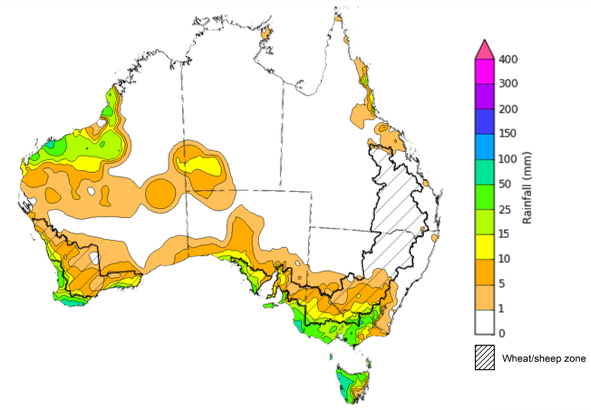
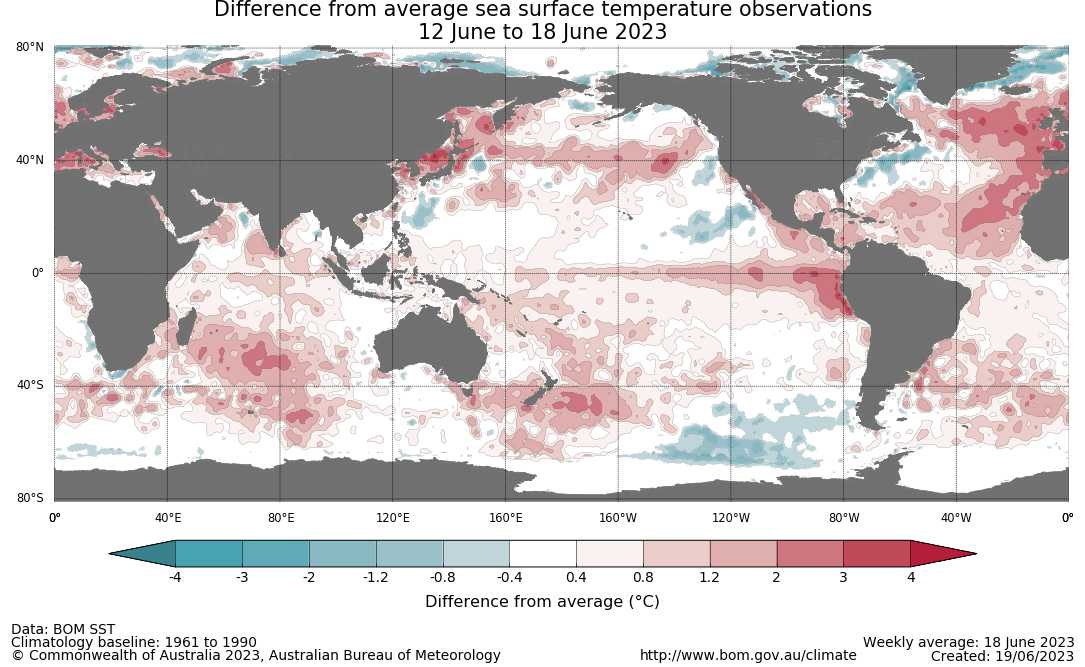
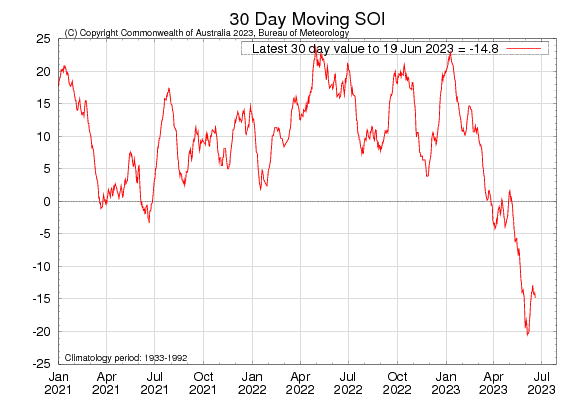
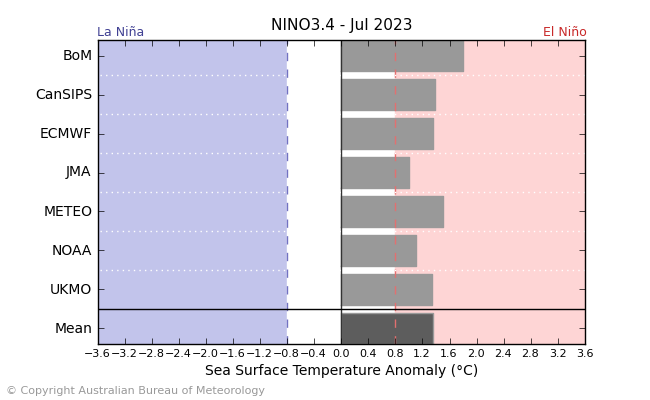
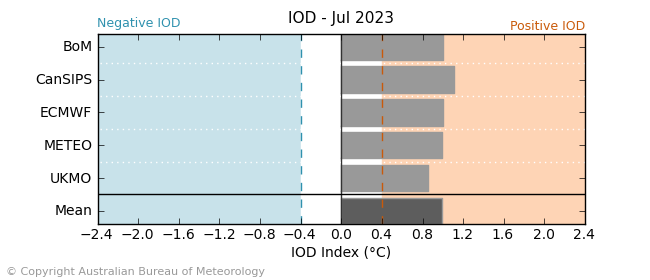
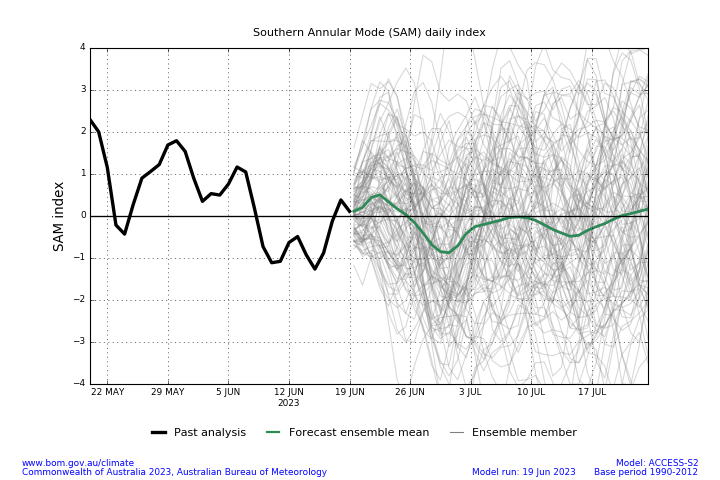
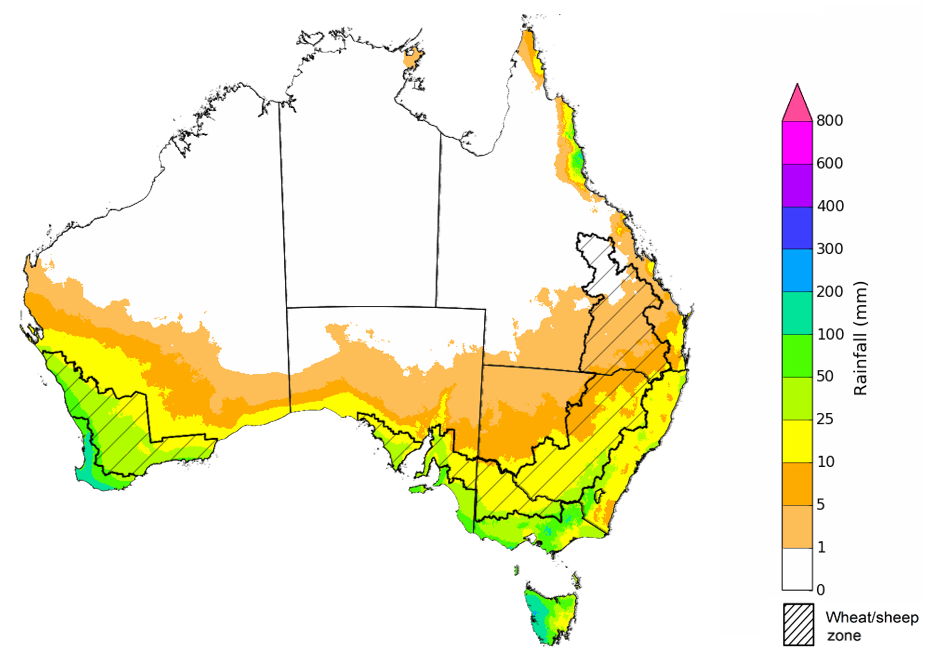
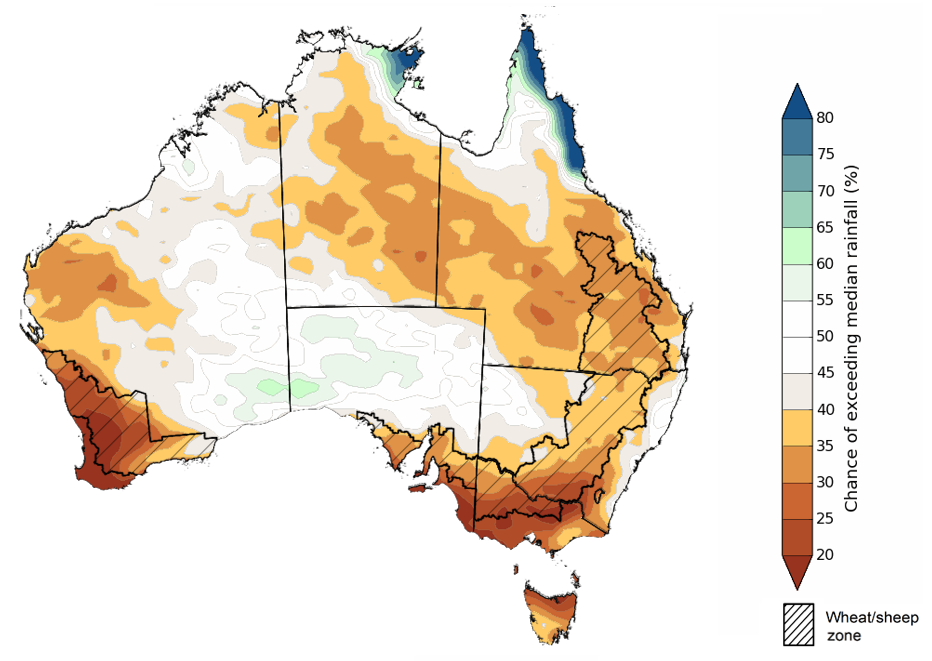
![Map showing the rainfall totals that have a 75% chance of occurring during the next three months in Australia. Image provided by the Bureau of Meteorology. Please refer to accompanying text for a more detailed description.]](/sites/default/files/images/rain.forecast.calib_.scenario.75.national.season1.latest.hr__32.png)
